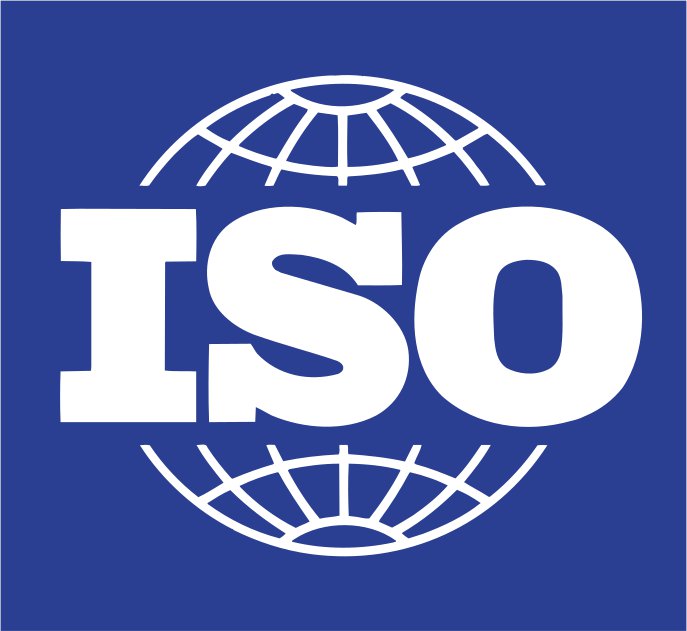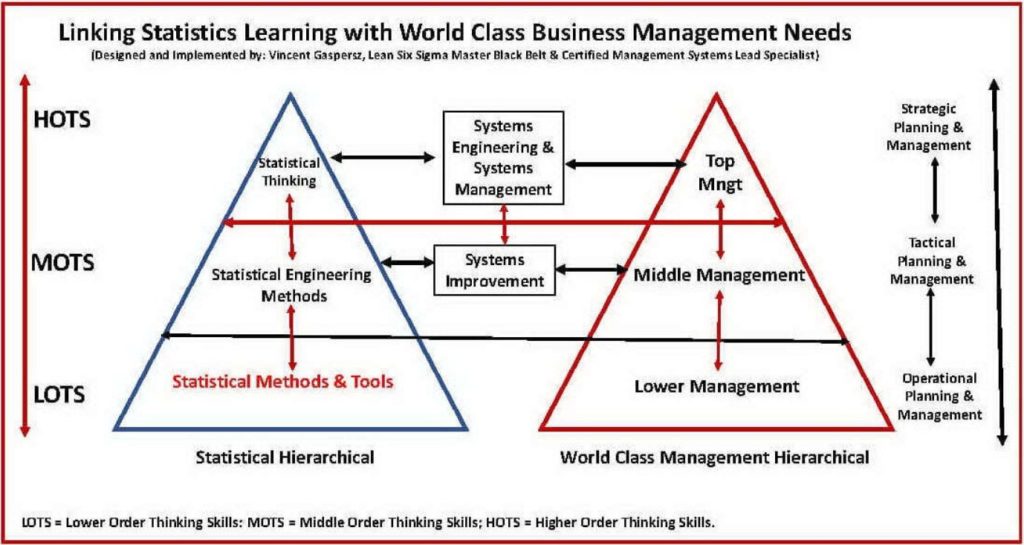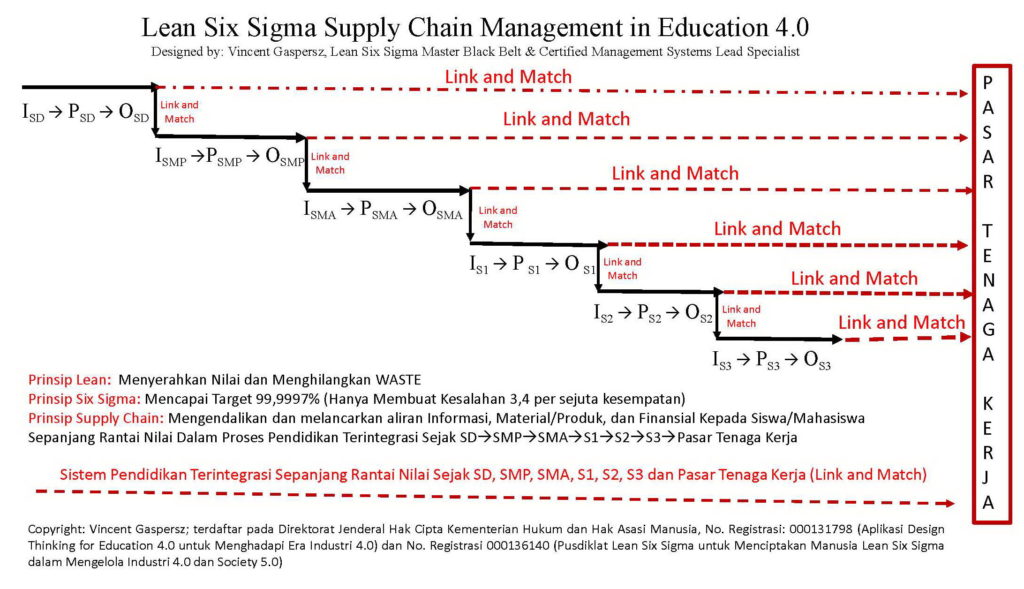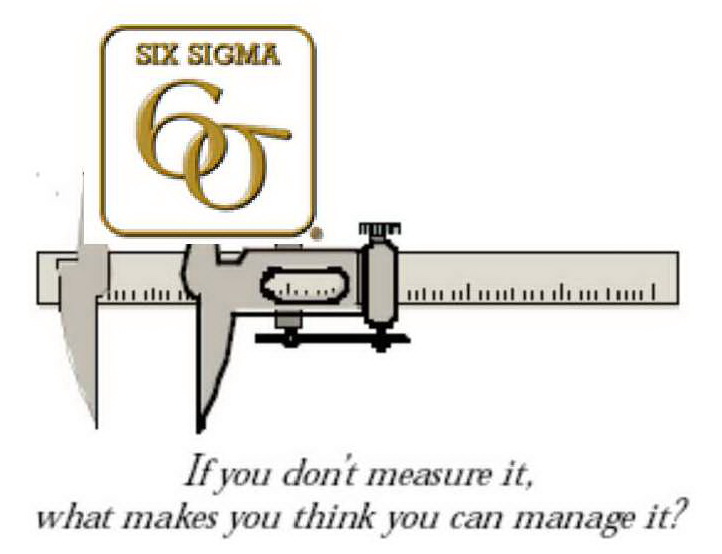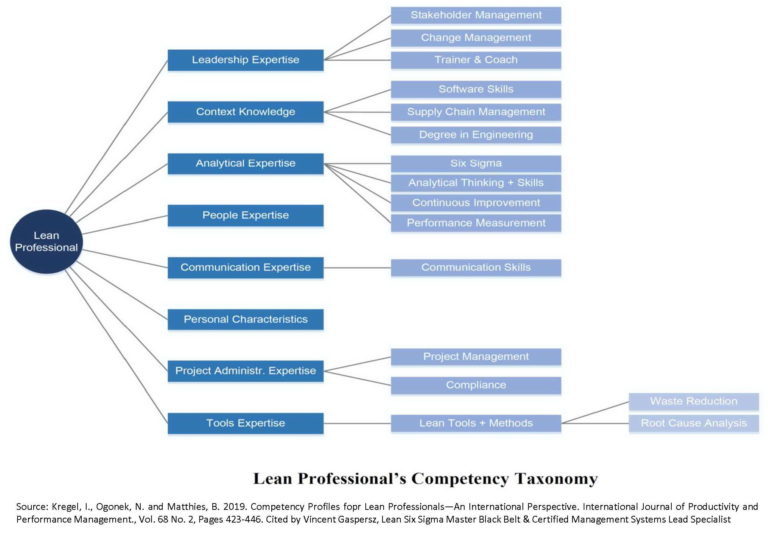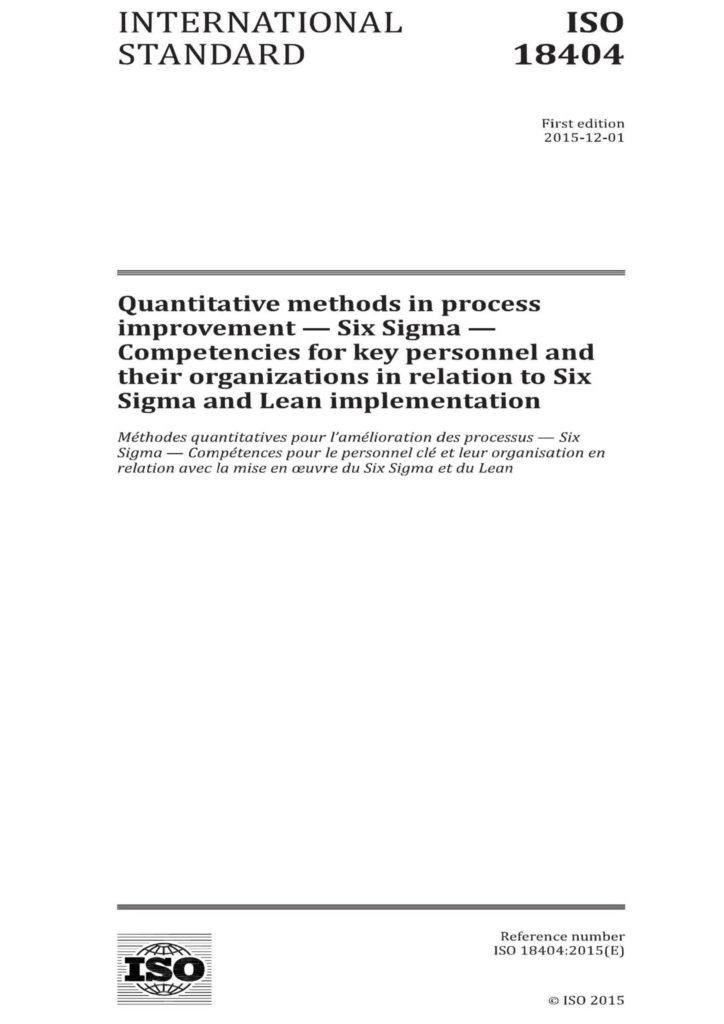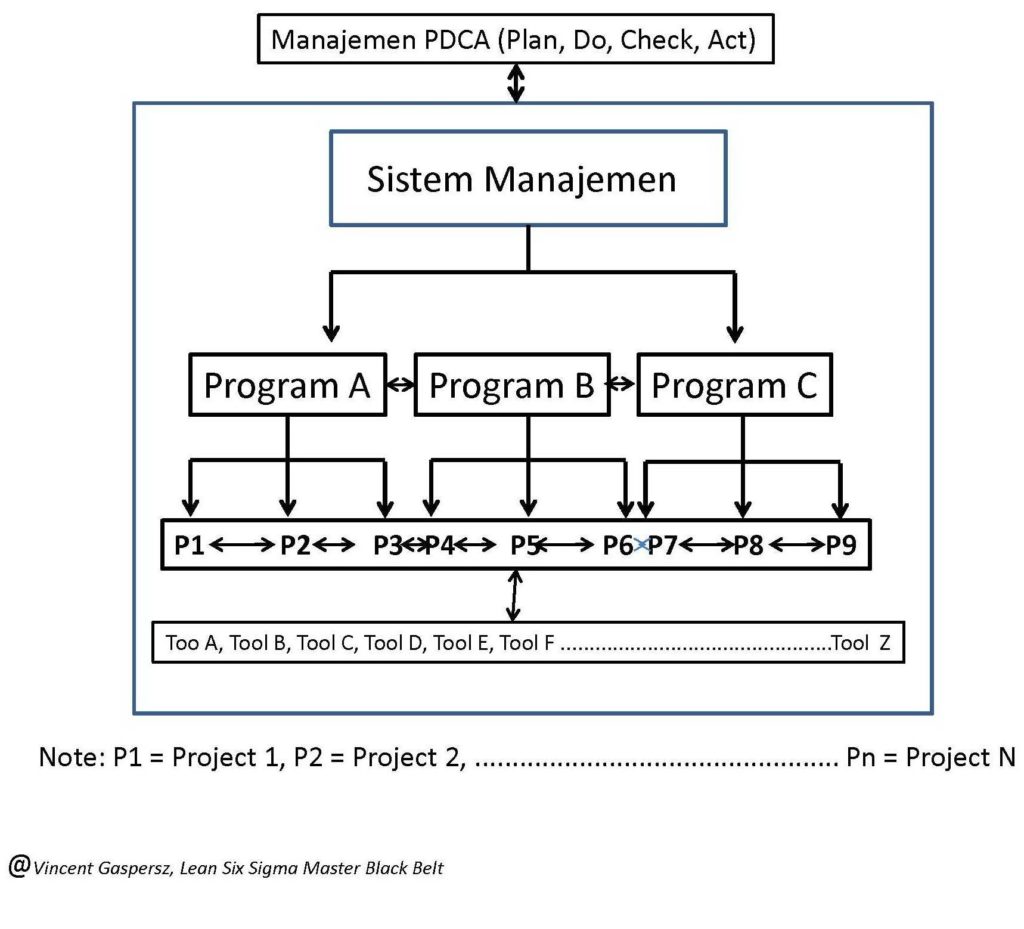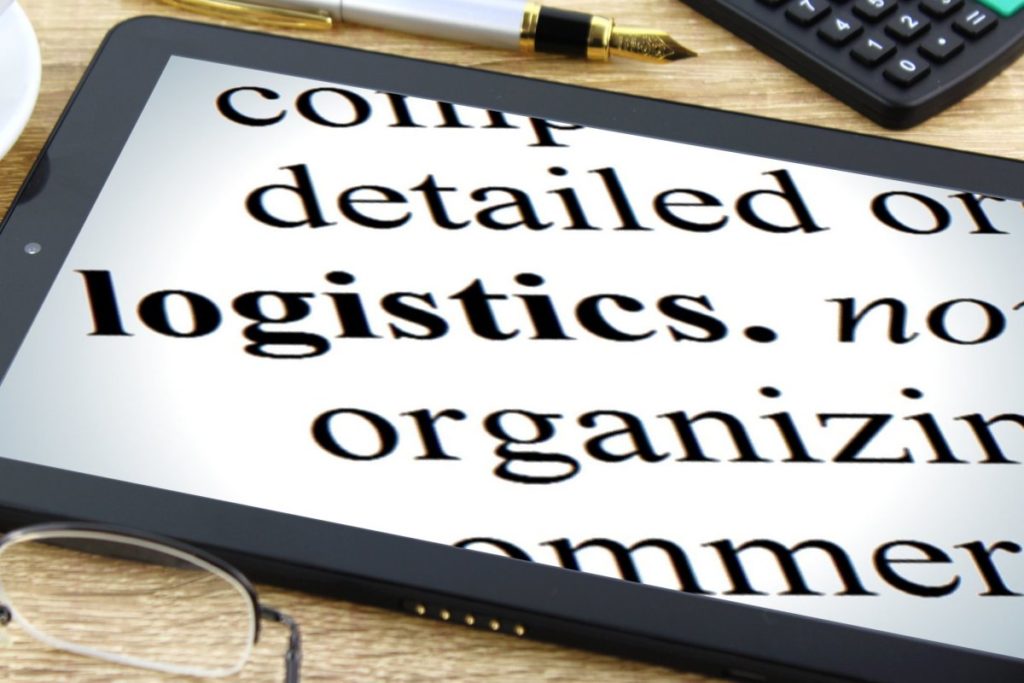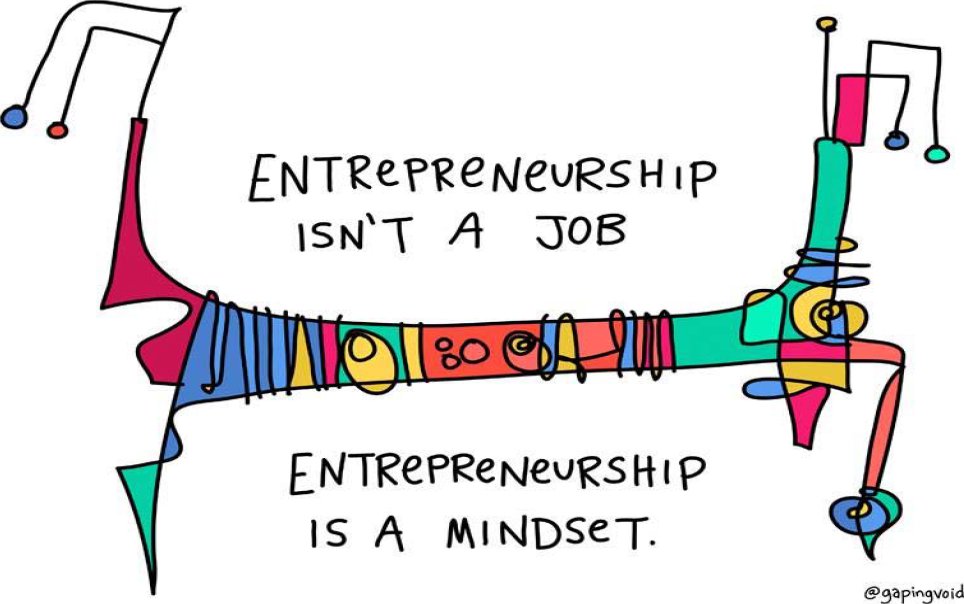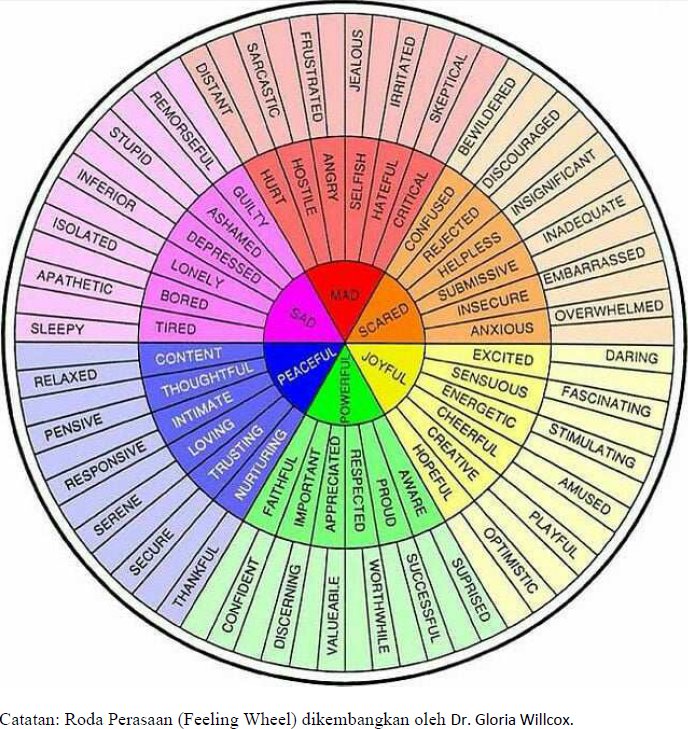-
Bahasa Indonesia
-
English
Oleh: Vincent Gaspersz, Lean Six Sigma Master Black Belt & Certified Management System Lead Specialist
- APICS (www.apics.org) Certified Fellow in Production and Inventory Management (CFPIM) and Certified Supply Chain Professional (CSCP);
- International Quality Federation (www.iqf.org) Six Sigma Master Black Belt (SSMBB);
- ASQ (www.asq.org) Certified Manager of Quality/Organizational Excellence (CMQ/OE), Certified Quality Engineer (CQE), Certified Quality Auditor (CQA), Certified Six Sigma Black Belt (CSSBB), Certified Quality Improvement Associate (CQIA);
- Registration Accreditation Board (www.exemplarglobal.org) Certified Management System Lead Specialist (CMSLS).
- Senior Member of American Society for Quality (Member #: 00749775), International Member of American Production and Inventory Control Society (Member #: 1023620), and Senior Member of Institute of Industrial and Systems Engineers (Member #: 880194630).
Salah satu area pengetahuan atau area konsentrasi dari 12 area pengetahuan yang dipublikasikan oleh IISE (Institute of Industrial and Systems Engineers) pada September 2016 adalah: Operations Engineering & Management yang pernah dibahas dalam facebook ini.
https://www.facebook.com/vincent.gaspersz/posts/1668025553221616
Demikian pula KOMPETENSI minimum berkaitan dengan ujian APICS CPIM (Certified in Production and Inventory Management) pernah dibahas dalam facebook ini.
https://www.facebook.com/vincent.gaspersz/posts/1668143906543114
Dari dua sumber informasi itu kita bisa menyusun kurikulum atau belajar mandiri untuk meningkatkan KOMPETENSI minimum dalam bidang Operations Management.
Dalam program studi Teknik dan Manajemen Industri, program studi manajemen konsentrasi manajemen produksi, dan program studi lainnya, mata kuliah Operations Management merupakan mata kuliah wajib yang HARUS diikuti selama proses pembelajaran S1, S2 maupun S3. Jika program studi itu HANYA memberikan nilai kelulusan saja TANPA menjamin KOMPETENSI minimum, maka kita sebagai pribadi mandiri dapat mengukur KOMPETENSI kita itu secara jujur untuk menyiapkan ketika memasuki dunia kerja dan/atau diterapkan dalam aktivitas professional.
Mengingat pentingnya Operations Management ini, maka lembaga internasional ISO (International Organization for Standardization) telah menerbitkan ISO/IEC 62264-3:2016 dengan judul: Enterprise-control system integration – Part 3: Activity models of manufacturing operations management yang mendefinisikan tentang model-model aktivitas manajemen operasional manufaktur sehingga memungkinkan sistem perusahaan untuk mengendalikan sistem-sistem terintegrasi yang ada.
Setelah memahami operations management versi ISO ini, maka kita memiliki informasi yang lengkap untuk dapat menyusun kurikulum, silabus mata kuliah, atau menyiapkan diri secara mandiri untuk mencapai KOMPETENSI minimum yang diharapkan bersdasarkan standar internasional dan akan MAMPU berkompetisi dan/atau bekerja sama dengan professional yang berasal dari berbagai negara di dunia. Model semacam ini akan jauh lebih EFEKTIF dan EFISIEN, daripada hanya mengumpulkan beberapa textbooks kemudian belajar mandiri dari buku-buku teks itu atau menyusun kurikulum dan/atau isi silabus melalui hanya mencuplik hal-hal yang dianggap penting dalam isi buku-buku teks itu. Kerangka pembelajaran seperti ini yang disebut oleh penulis (VG) sebagai TIDAK memiliki standar internasional. Jika kita TIDAK mengacu pada Standar Internasional, maka meskipun kita memiliki nilai indeks prestasi tertinggi (maksimum) dalam Operations Management, hal itu TIDAK menjamin bahwa kita telah memiliki KOMPETENSI minimum dalam Operations Management.
Struktur ISO/IEC 62264-3:2016
Kerangka kerja atau isi dari ISO/IEC 62264-3:2016 adalah sebagai berikut:
CONTENTS
FOREWORD
INTRODUCTION
- Scope
- Normative references
- Terms, definitions and abbreviations
- Terms and definitions
- Abbreviations
- Structuring concepts
- Activity models
- Manufacturing operations management
- Structuring models
- Generic template for categories of manufacturing operations management
- Template for management of operations
- Use of the generic model
- Generic activity model
- Interaction among generic activity models
- Information flows between generic activity models
- Handling resources within the generic activity models
- Scheduling interactions
- Hierarchy of planning and scheduling
- Resource definition for scheduling activities
- Consumed resources and non-consumed resources
- Resource capacity and availability
- Generic template for categories of manufacturing operations management
- Production operations management
- General activities in production operations management
- Production operations management activity model
- Information exchange in production operations management
- Equipment and process specific production rules
- Operational commands
- Operational responses
- Equipment and process specific data
- Product definition management
- Activity definition of product definition management
- Activity model of product definition management
- Tasks in product definition management
- Product definition management information
- Production resource management
- Activity definition of production resource management
- Activity model of production resource management
- Tasks in production resource management
- Production resource management information
- Detailed production scheduling
- Activity definition of detailed production scheduling
- Activity model of detailed production scheduling
- Tasks in detailed production scheduling
- Detailed production scheduling information
- Production dispatching
- Activity definition of production dispatching
- Activity model of production dispatching
- Tasks in production dispatching
- Production dispatching information
- Production execution management
- Activity definition of production execution management
- Activity model of production execution management
- Tasks in production execution management
- Production data collection
- Activity definition in production data collection
- Activity model of production data collection
- Tasks in production data collection
- Production tracking
- Activity definition of production tracking
- Activity model of production tracking
- Tasks in production tracking
- Production performance analysis
- Activity definition of production performance analysis
- Activity model of production performance analysis
- Tasks in production performance analysis
- Maintenance operations management
- General activities in maintenance operations management
- Maintenance operations management activity model
- Information exchanged in maintenance operations management
- Maintenance information
- Maintenance definitions
- Maintenance capability
- Maintenance request
- Maintenance response
- Equipment-specific maintenance procedures
- Maintenance commands and procedures
- Maintenance results
- Equipment state-of-health data
- Maintenance definition management
- Maintenance resource management
- Detailed maintenance scheduling
- Maintenance dispatching
- Maintenance execution management
- Maintenance data collection
- Maintenance tracking
- Maintenance performance analysis
- Quality operations management
- General activities in quality operations management
- Quality operations management activities
- Quality operations scope
- Quality test operations management
- Types of testing
- Testing locations and times
- Quality systems
- Quality test operations activity model
- Information exchanged in quality test operations management
- Quality test definitions
- Quality test capability
- Quality test request
- Quality test response
- Quality parameters and procedures
- Test commands
- Test responses
- Quality-specific data
- Quality test definition management
- Quality test resource management
- Detailed quality test scheduling
- Quality test dispatching
- Quality test execution management
- General
- Testing
- Quality test data collection
- Quality test tracking
- Quality test performance analysis
- General
- Quality resource traceability analysis
- Quality indicators
- Supported activities
- General activities in quality operations management
- Inventory operations management
- General activities in inventory operations management
- Inventory operations management activity model
- Information exchanged in inventory operations management
- Inventory definitions
- Inventory capability
- Inventory requests
- Inventory response
- Inventory storage definitions
- Inventory commands
- Inventory replies
- Inventory-specific data
- Inventory definition management
- Inventory resource management
- Detailed inventory scheduling
- Inventory dispatching
- Inventory execution management
- Inventory data collection
- Inventory tracking
- Inventory performance analysis
- Completeness, compliance and conformance
- Completeness
- Compliance
- Conformance
- Annex A (informative) Technical and responsibility boundaries
- General
- Scope of responsibility
- Actual responsibility
- Technical integration
- Defining solutions
- Annex B (informative) Scheduling hierarchy
- Annex C (informative) Frequently asked questions.
- Does this standard apply to more than just manufacturing applications?
- Why are the models more detailed for production operations management than for the other categories?
- What are some of the main expected uses of this standard?
- How does this standard relate to enterprise-control system integration?
- How does this facilitate connection to ERP systems?
- Why is genealogy not discussed?
- Why are only some information flows shown?
- What industry does the standard apply to?
- What is the relation between this standard and MES?
- How does the QA (quality assurance) element in IEC 62264-1 relate to this standard?
- Annex D (informative) Advanced planning and scheduling concepts for manufacturing operations management
- General
- Fundamental technologies of APS
- Decision-making functions of APS
Bibliography
Dari kerangka kerja ISO/IEC 62264-3:2016 tentang Operations Management di atas, kita mengetahui bahwa seseorang yang memiliki KOMPETENSI minimum dalam Operations Management HARUS memahami secara baik topik-topik utama berikut:
- Structuring concepts of Operations Management
- Structuring models of Operations Management
- Production operations management
- Maintenance operations management
- Quality operations management
- Inventory operations management
- Completeness, compliance and conformance
Topik-topik utama dalam Operations Management dari ISO/ IEC 62264-3:2016 di atas seyogianya dipelajari sampai tuntas di program studi yang memiliki area konsentrasi Operations Management, apakah dalam dua atau tiga semester. Sehingga kita BUKAN sekedar menambah topik-topik lain di luar topik-topik utama di atas, di mana pembelajaran dari topik-topik tambahan itu TIDAK TUNTAS hanya dipermukaan saja berupa definisi dan beberapa konsep umum yang TIDAK mendukung KOMPETENSI minimum dalam Operations Management.
Jika kita menganggap masih ada waktu pembelajaran dan ingin menambah topik-topik tambahan, maka seyogianya ditambah dengan topik-topik yang sangat relevan dan berkaitan erat dengan Operations Management itu, misalnya menambah pembelajaran tentang Key Performance Indicators (KPIs) dalam Operations Management versi ISO 22400-2:2014 dengan judul: Automation systems and integration – Key performance indicators (KPIs) for manufacturing operations management – Part 2: Definitions and descriptions, yang akan dibahas berikut ini.
Kerangka Kerja (Isi) ISO 22400-2:2014
Foreword
Introduction
- Scope
- Conformance
- Normative references
- Terms and definitions
- Symbols (and abbreviated terms)
- Component elements of KPIs
- Time Descriptions
- Notations
- Planned periods
- Actual times
- Time model for production units
- Time model for manufacturing order
- Time model for employment
- Logistical quantities
- Order quantity (POQ)
- Wastage quantity (SQ)
- Planned wastage quantity (PSQ)
- Good quantity (GQ)
- Rework quantity (RQ)
- Produced quantity (PQ) quantities
- Organizational quantities
- Work sequence (OS)
- Operation (AG)
- Working group (AGR)
- Workplace (WP)
- Manufacturing order (PO)
- Machine (MA)
- Production unit (PU)
- Quality figures
- Good parts (GP)
- Inspected parts (IP)
- Arithmetic Average
- Average of average values
- Upper limit value (ULV)
- Standard deviation (s)
- Estimated value
- Lower limit value (LLV)
- Variance
- Specific KPIs
- Worker productivity
- Allocation degree
- Throughput
- Allocation efficiency
- Efficiency
- OEE (Overall Equipment Effectiveness) Index
- NEE (Net Overall Equipment Effectiveness) Index
- Availability
- Effectiveness
- Quality Rate
- Preparation degree
- Technical Usage Level
- Wastage Degree
- First Pass Yield (FPY)
- Wastage Ratio
- Reworking Ratio
- Fall off Rate
- Machine Capability Index (Cm)
- Critical Machine Capability Index (Cmk)
- Process Capability Index (Cp)
- Critical Process Capability Index (Cpk)
- Environmental compatibility KPIs
- Selection of environmental KPIs
- Emission ratio
- Energy ratio
- Ratio of used material
- Harmful substances
- Hazardous waste
- KPIs for energy consumption
- Comprehensive Energy Consumption
- KPIs for inventory handling and management
- Inventory turns
- KPIs for input-output (quality of manufacturing process)
- Finished Goods Rate
- Integrated Goods Rate
- Production Lost Rate
- Storage and Transportation Lost Rate
- Other Lost Rate
- KPIs of Load Rate
- Equipment Load Rate
- Scope
- Conformance
- Normative references
- Terms and definitions
- Symbols (and abbreviated terms)
- Component elements of KPIs
- Time Descriptions
- Notations
- Planned periods
- Actual times
- Time model for production units
- Time model for manufacturing order
- Time model for employment
- Logistical quantities
- Order quantity (POQ)
- Wastage quantity (SQ)
- Planned wastage quantity (PSQ)
- Good quantity (GQ)
- Rework quantity (RQ)
- Produced quantity (PQ) quantities
- Organizational quantities
- Work sequence (OS)
- Operation (AG)
- Working group (AGR)
- Workplace (WP)
- Manufacturing order (PO)
- Machine (MA)
- Production unit (PU)
- Quality figures
- Good parts (GP)
- Inspected parts (IP)
- Arithmetic Average
- Average of average values
- Upper limit value (ULV)
- Standard deviation (s)
- Estimated value
- Lower limit value (LLV)
- Variance
- Time Descriptions
- Specific KPIs
- Worker productivity
- Allocation degree
- Throughput
- Allocation efficiency
- Efficiency
- OEE (Overall Equipment Effectiveness) Index
- NEE (Net Overall Equipment Effectiveness) Index
- Availability
- Effectiveness
- Quality Rate
- Preparation degree
- Technical Usage Level
- Wastage Degree
- First Pass Yield (FPY)
- Wastage Ratio
- Reworking Ratio
- Fall off Rate
- Machine Capability Index (Cm)
- Critical Machine Capability Index (Cmk)
- Process Capability Index (Cp)
- Critical Process Capability Index (Cpk)
- Environmental compatibility KPIs
- Selection of environmental KPIs
- Emission ratio
- Energy ratio
- Ratio of used material
- Harmful substances
- Hazardous waste
- KPIs for energy consumption
- Comprehensive Energy Consumption
- KPIs for inventory handling and management
- Inventory turns
- KPIs for input-output (quality of manufacturing process)
- Finished Goods Rate
- Integrated Goods Rate
- Production Lost Rate
- Storage and Transportation Lost Rate
- Other Lost Rate
- KPIs of Load Rate
- Equipment Load Rate
Bibliography
Daftar Referensi
- IISE 2016., The Industrial Engineering Body of Knowledge, Institute of Industrial and Systems Engineers, Georgia, USA.
- ISO 2014., ISO 22400-2:2014. Automation systems and integration – Key
performance indicators (KPIs) for manufacturing operations management – - Part 2: Definitions and descriptions, Geneva, Switzerland.
- ISO. 2016., ISO/IEC 62264-3:2016. Enterprise-control system integration – Part 3: Activity models of manufacturing operations management, Geneva, Switzerland.
- http://www.apics.org/credentials-education/credentials/cpim
Understanding ISO’s Operations Management
By: Vincent Gaspersz, Lean Six Sigma Master Black Belt & Certified Management System Lead Specialist
- APICS (www.apics.org) Certified Fellow in Production and Inventory Management (CFPIM) and Certified Supply Chain Professional (CSCP);
- International Quality Federation (www.iqf.org) Six Sigma Master Black Belt (SSMBB);
- ASQ (www.asq.org) Certified Manager of Quality/Organizational Excellence (CMQ/OE), Certified Quality Engineer (CQE), Certified Quality Auditor (CQA), Certified Six Sigma Black Belt (CSSBB), Certified Quality Improvement Associate (CQIA);
- Registration Accreditation Board (www.exemplarglobal.org) Certified Management System Lead Specialist (CMSLS).
- Senior Member of American Society for Quality (Member #: 00749775), International Member of American Production and Inventory Control Society (Member #: 1023620), and Senior Member of Institute of Industrial and Systems Engineers (Member #: 880194630).
One knowledge or concentration area of the 12 areas of knowledge published by IISE (Institute of Industrial and Systems Engineers) in September 2016 is: Operations Engineering & Management, which have been discussed in this facebook article:
https://www.facebook.com/vincent.gaspersz/posts/1668025553221616
Similarly, the minimum COMPETENCIES related to the APICS CPIM (Certified in Production and Inventory Management) exam has been discussed in this facebook article:
https://www.facebook.com/vincent.gaspersz/posts/1668143906543114
From those two sources of information, we can prepare a curriculum or self-study to improve the minimum COMPETENCIES in Operations Management.
In an Industrial Engineering and Management study program, a Production Management concentrated study program, and other study programs, the Operations Management course is a compulsory subject that MUST be taken during the learning processes of Bachelor’s, Master’s or Doctorate degree. If that study program ONLY gives passing grades WITHOUT guaranteeing minimum COMPETENCIES, then we, as an independent person, can honestly measure our COMPETENCIES to prepare ourselves when entering the workforce and/or to apply those COMPETENCIES in professional activities.
Knowing the importance of this Operations Management, the International Organization for Standardization has released ISO/IEC 62264-3:2016, entitled: Enterprise-control system integration – Part 3: Activity models of manufacturing operations management, that defines the models of manufacturing operations management activities; thus, enabling companies’ systems to control their existing integrated systems.
After having understood this ISO’s operations management, we would have had complete information to be able to develop curricula, course syllabi, or to independently prepare ourselves to achieve minimum COMPETENCIES expected based on international standards that will enable us to compete and/or cooperate with professionals from various countries in the world. Such model will be far more EFFECTIVE and EFFICIENT, than just by collecting some textbooks and then studying independently from those textbooks or by putting together the content of a curriculum and/or syllabus through simply extracting what is considered important in the contents of those textbooks. This kind of learning framework does NOT have international standards. If we do NOT refer to International Standards, even if we have the highest (maximum) GPA in Operations Management, that does NOT guarantee that we already have had the minimum COMPETENCIES in Operations Management.
Struktur ISO/IEC 62264-3:2016
The framework or content of ISO/IEC 62264-3:2016 is as follows:
CONTENTS
FOREWORD
INTRODUCTION
- Scope
- Normative references
- Terms, definitions and abbreviations
- Terms and definitions
- Abbreviations
- Structuring concepts
- Activity models
- Manufacturing operations management
- Structuring models
- Generic template for categories of manufacturing operations management
- Template for management of operations
- Use of the generic model
- Generic activity model
- Interaction among generic activity models
- Information flows between generic activity models
- Handling resources within the generic activity models
- Scheduling interactions
- Hierarchy of planning and scheduling
- Resource definition for scheduling activities
- Consumed resources and non-consumed resources
- Resource capacity and availability
- Generic template for categories of manufacturing operations management
- Production operations management
- General activities in production operations management
- Production operations management activity model
- Information exchange in production operations management
- Equipment and process specific production rules
- Operational commands
- Operational responses
- Equipment and process specific data
- Product definition management
- Activity definition of product definition management
- Activity model of product definition management
- Tasks in product definition management
- Product definition management information
- Production resource management
- Activity definition of production resource management
- Activity model of production resource management
- Tasks in production resource management
- Production resource management information
- Detailed production scheduling
- Activity definition of detailed production scheduling
- Activity model of detailed production scheduling
- Tasks in detailed production scheduling
- Detailed production scheduling information
- Production dispatching
- Activity definition of production dispatching
- Activity model of production dispatching
- Tasks in production dispatching
- Production dispatching information
- Production execution management
- Activity definition of production execution management
- Activity model of production execution management
- Tasks in production execution management
- Production data collection
- Activity definition in production data collection
- Activity model of production data collection
- Tasks in production data collection
- Production tracking
- Activity definition of production tracking
- Activity model of production tracking
- Tasks in production tracking
- Production performance analysis
- Activity definition of production performance analysis
- Activity model of production performance analysis
- Tasks in production performance analysis
- Maintenance operations management
- General activities in maintenance operations management
- Maintenance operations management activity model
- Information exchanged in maintenance operations management
- Maintenance information
- Maintenance definitions
- Maintenance capability
- Maintenance request
- Maintenance response
- Equipment-specific maintenance procedures
- Maintenance commands and procedures
- Maintenance results
- Equipment state-of-health data
- Maintenance definition management
- Maintenance resource management
- Detailed maintenance scheduling
- Maintenance dispatching
- Maintenance execution management
- Maintenance data collection
- Maintenance tracking
- Maintenance performance analysis
- Quality operations management
- General activities in quality operations management
- Quality operations management activities
- Quality operations scope
- Quality test operations management
- Types of testing
- Testing locations and times
- Quality systems
- Quality test operations activity model
- Information exchanged in quality test operations management
- Quality test definitions
- Quality test capability
- Quality test request
- Quality test response
- Quality parameters and procedures
- Test commands
- Test responses
- Quality-specific data
- Quality test definition management
- Quality test resource management
- Detailed quality test scheduling
- Quality test dispatching
- Quality test execution management
- General
- Testing
- Quality test data collection
- Quality test tracking
- Quality test performance analysis
- General
- Quality resource traceability analysis
- Quality indicators
- Supported activities
- General activities in quality operations management
- Inventory operations management
- General activities in inventory operations management
- Inventory operations management activity model
- Information exchanged in inventory operations management
- Inventory definitions
- Inventory capability
- Inventory requests
- Inventory response
- Inventory storage definitions
- Inventory commands
- Inventory replies
- Inventory-specific data
- Inventory definition management
- Inventory resource management
- Detailed inventory scheduling
- Inventory dispatching
- Inventory execution management
- Inventory data collection
- Inventory tracking
- Inventory performance analysis
- Completeness, compliance and conformance
- Completeness
- Compliance
- Conformance
- Annex A (informative) Technical and responsibility boundaries
- General
- Scope of responsibility
- Actual responsibility
- Technical integration
- Defining solutions
- Annex B (informative) Scheduling hierarchy
- Annex C (informative) Frequently asked questions.
- Does this standard apply to more than just manufacturing applications?
- Why are the models more detailed for production operations management than for the other categories?
- What are some of the main expected uses of this standard?
- How does this standard relate to enterprise-control system integration?
- How does this facilitate connection to ERP systems?
- Why is genealogy not discussed?
- Why are only some information flows shown?
- What industry does the standard apply to?
- What is the relation between this standard and MES?
- How does the QA (quality assurance) element in IEC 62264-1 relate to this standard?
- Annex D (informative) Advanced planning and scheduling concepts for manufacturing operations management
- General
- Fundamental technologies of APS
- Decision-making functions of APS
Bibliography
From the ISO/IEC 62264-3:2016 framework of Operations Management above, we know that someone who has minimum COMPETENCIES in Operations Management MUST understand well the following key topics:
- Structuring concepts of Operations Management
- Structuring models of Operations Management
- Production operations management
- Maintenance operations management
- Quality operations management
- Inventory operations management
- Completeness, compliance and conformance
The main topics in Operations Management of ISO/IEC 62264-3:2016 above should be studied thoroughly in study programs that have a concentration area of Operations Management, whether in two or three semesters. Therefore, we would NOT just be adding other topics outside of the main topics above, where the learning from these additional topics is NOT COMPLETE and is touching only on the surfaces of definitions and some general concepts that do NOT support minimum COMPETENCIES in Operations Management.
Jika kita menganggapmasih ada waktu pembelajaran dan ingin menambah topik-topik tambahan, maka seyogianya ditambah dengan topik-topik yang sangat relevan dan berkaitan erat dengan Operations Management itu, misalnya menambah pembelajaran tentang Key Performance Indicators (KPIs) dalam Operations Management versi ISO 22400-2:2014 dengan judul: Automation systems and integration — Key performance indicators (KPIs) for manufacturing operations management — Part 2: Definitions and descriptions, yang akan dibahas berikut ini.
If we consider that there is still time to learn and we want to add additional topics, then we should add our learning with those topics that are very relevant and closely related to Operations Management. For example, we would learn more about Key Performance Indicators (KPIs) in Operations Management ISO 22400-2:2014 entitled: Automation systems and integration – Key performance indicators (KPIs) for manufacturing operations management – Part 2: Definitions and descriptions, which will be discussed below.
ISO 22400-2:2014 Framework (Content)
Foreword
Introduction
- Scope
- Conformance
- Normative references
- Terms and definitions
- Symbols (and abbreviated terms)
- Component elements of KPIs
- Time Descriptions
- Notations
- Planned periods
- Actual times
- Time model for production units
- Time model for manufacturing order
- Time model for employment
- Logistical quantities
- Order quantity (POQ)
- Wastage quantity (SQ)
- Planned wastage quantity (PSQ)
- Good quantity (GQ)
- Rework quantity (RQ)
- Produced quantity (PQ) quantities
- Organizational quantities
- Work sequence (OS)
- Operation (AG)
- Working group (AGR)
- Workplace (WP)
- Manufacturing order (PO)
- Machine (MA)
- Production unit (PU)
- Quality figures
- Good parts (GP)
- Inspected parts (IP)
- Arithmetic Average
- Average of average values
- Upper limit value (ULV)
- Standard deviation (s)
- Estimated value
- Lower limit value (LLV)
- Variance
- Specific KPIs
- Worker productivity
- Allocation degree
- Throughput
- Allocation efficiency
- Efficiency
- OEE (Overall Equipment Effectiveness) Index
- NEE (Net Overall Equipment Effectiveness) Index
- Availability
- Effectiveness
- Quality Rate
- Preparation degree
- Technical Usage Level
- Wastage Degree
- First Pass Yield (FPY)
- Wastage Ratio
- Reworking Ratio
- Fall off Rate
- Machine Capability Index (Cm)
- Critical Machine Capability Index (Cmk)
- Process Capability Index (Cp)
- Critical Process Capability Index (Cpk)
- Environmental compatibility KPIs
- Selection of environmental KPIs
- Emission ratio
- Energy ratio
- Ratio of used material
- Harmful substances
- Hazardous waste
- KPIs for energy consumption
- Comprehensive Energy Consumption
- KPIs for inventory handling and management
- Inventory turns
- KPIs for input-output (quality of manufacturing process)
- Finished Goods Rate
- Integrated Goods Rate
- Production Lost Rate
- Storage and Transportation Lost Rate
- Other Lost Rate
- KPIs of Load Rate
- Equipment Load Rate
- Scope
- Conformance
- Normative references
- Terms and definitions
- Symbols (and abbreviated terms)
- Component elements of KPIs
- Time Descriptions
- Notations
- Planned periods
- Actual times
- Time model for production units
- Time model for manufacturing order
- Time model for employment
- Logistical quantities
- Order quantity (POQ)
- Wastage quantity (SQ)
- Planned wastage quantity (PSQ)
- Good quantity (GQ)
- Rework quantity (RQ)
- Produced quantity (PQ) quantities
- Organizational quantities
- Work sequence (OS)
- Operation (AG)
- Working group (AGR)
- Workplace (WP)
- Manufacturing order (PO)
- Machine (MA)
- Production unit (PU)
- Quality figures
- Good parts (GP)
- Inspected parts (IP)
- Arithmetic Average
- Average of average values
- Upper limit value (ULV)
- Standard deviation (s)
- Estimated value
- Lower limit value (LLV)
- Variance
- Time Descriptions
- Specific KPIs
- Worker productivity
- Allocation degree
- Throughput
- Allocation efficiency
- Efficiency
- OEE (Overall Equipment Effectiveness) Index
- NEE (Net Overall Equipment Effectiveness) Index
- Availability
- Effectiveness
- Quality Rate
- Preparation degree
- Technical Usage Level
- Wastage Degree
- First Pass Yield (FPY)
- Wastage Ratio
- Reworking Ratio
- Fall off Rate
- Machine Capability Index (Cm)
- Critical Machine Capability Index (Cmk)
- Process Capability Index (Cp)
- Critical Process Capability Index (Cpk)
- Environmental compatibility KPIs
- Selection of environmental KPIs
- Emission ratio
- Energy ratio
- Ratio of used material
- Harmful substances
- Hazardous waste
- KPIs for energy consumption
- Comprehensive Energy Consumption
- KPIs for inventory handling and management
- Inventory turns
- KPIs for input-output (quality of manufacturing process)
- Finished Goods Rate
- Integrated Goods Rate
- Production Lost Rate
- Storage and Transportation Lost Rate
- Other Lost Rate
- KPIs of Load Rate
- Equipment Load Rate
Bibliography
Daftar Referensi
- IISE 2016., The Industrial Engineering Body of Knowledge, Institute of Industrial and Systems Engineers, Georgia, USA.
- ISO 2014., ISO 22400-2:2014. Automation systems and integration – Key
performance indicators (KPIs) for manufacturing operations management – - Part 2: Definitions and descriptions, Geneva, Switzerland.
- ISO. 2016., ISO/IEC 62264-3:2016. Enterprise-control system integration – Part 3: Activity models of manufacturing operations management, Geneva, Switzerland.
- http://www.apics.org/credentials-education/credentials/cpim
